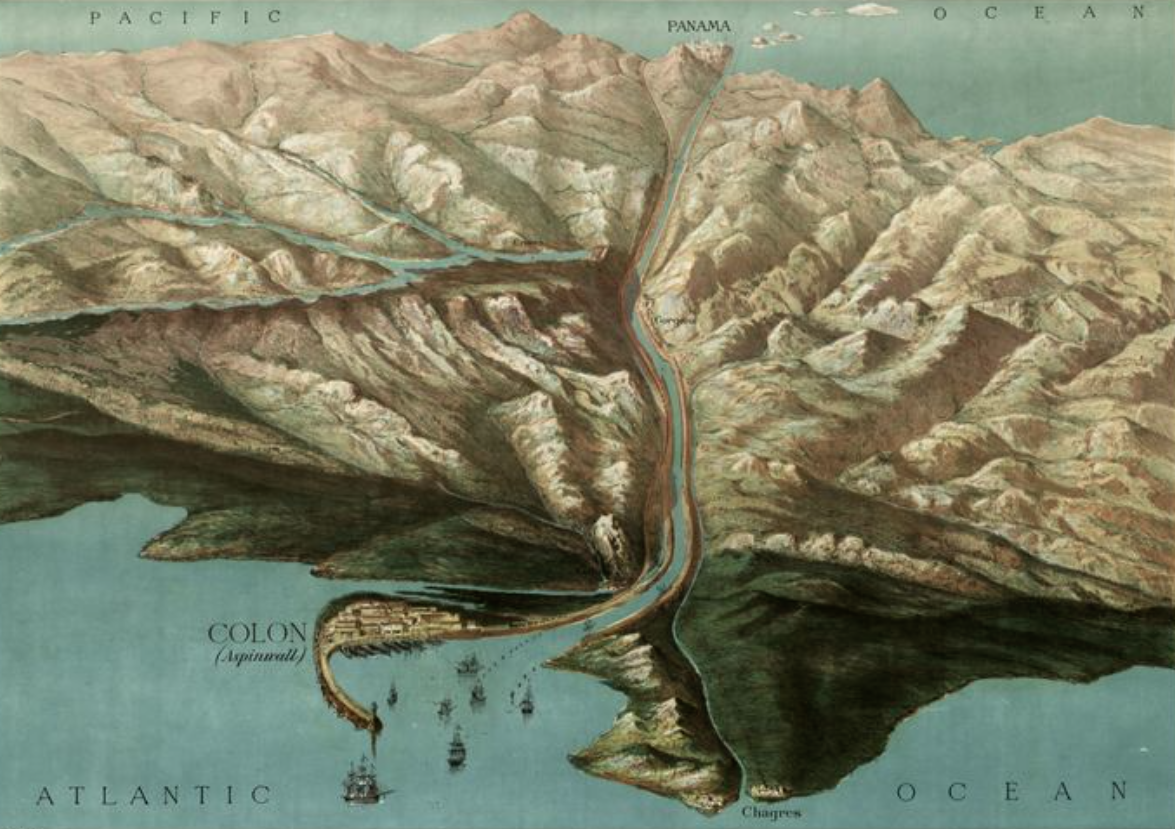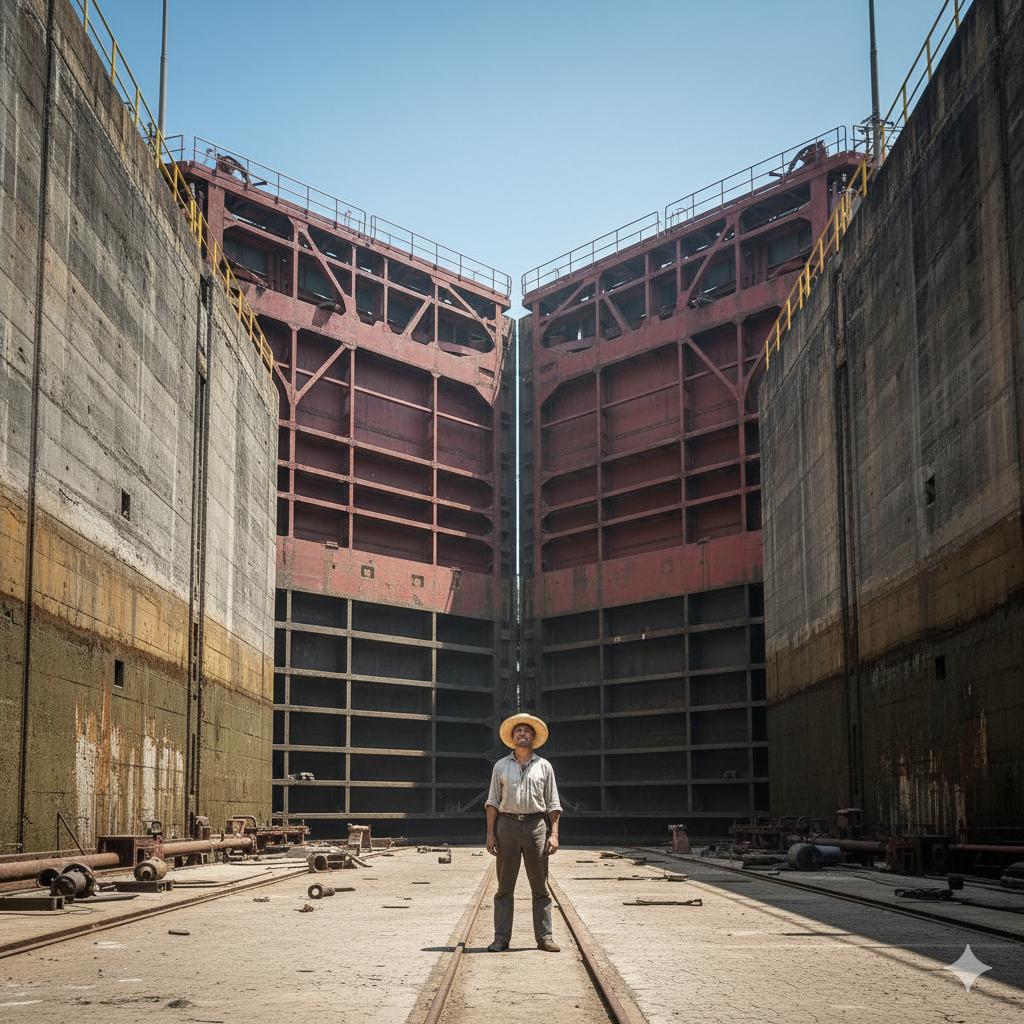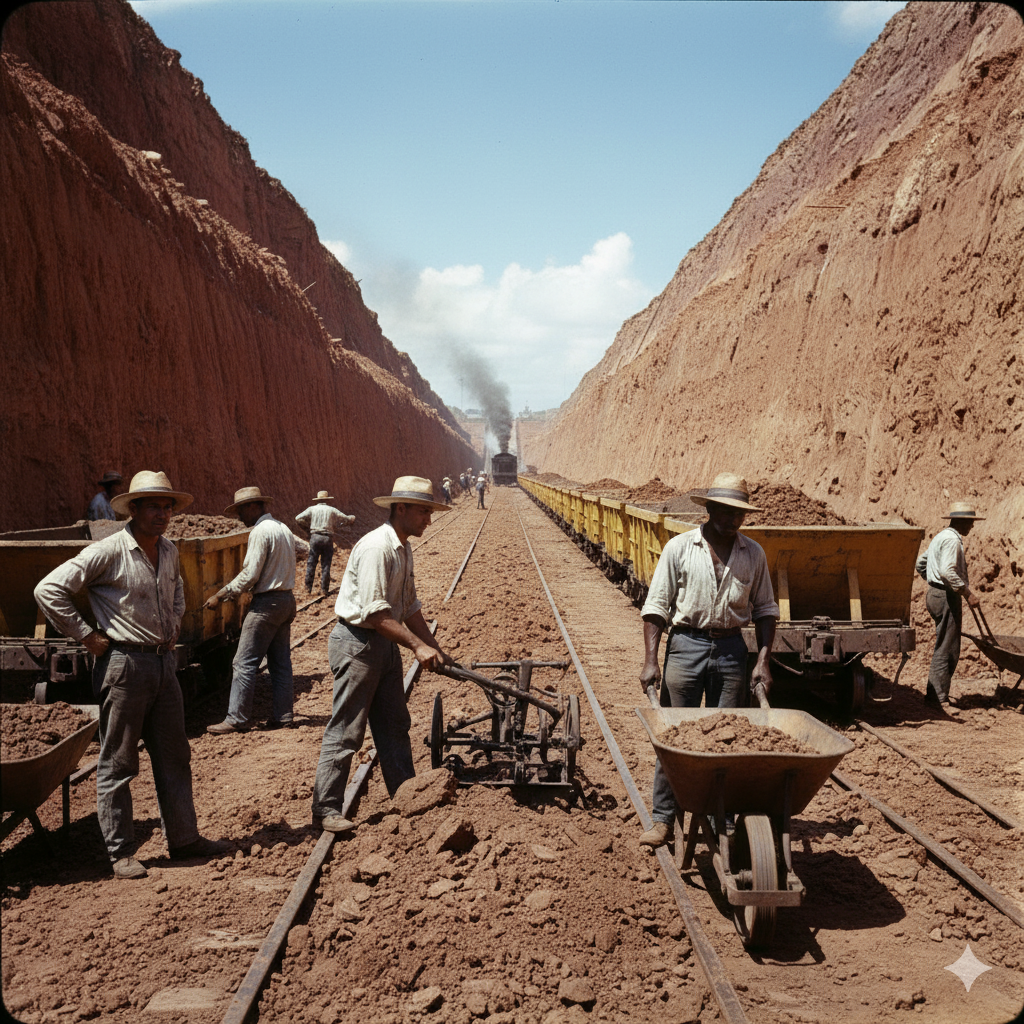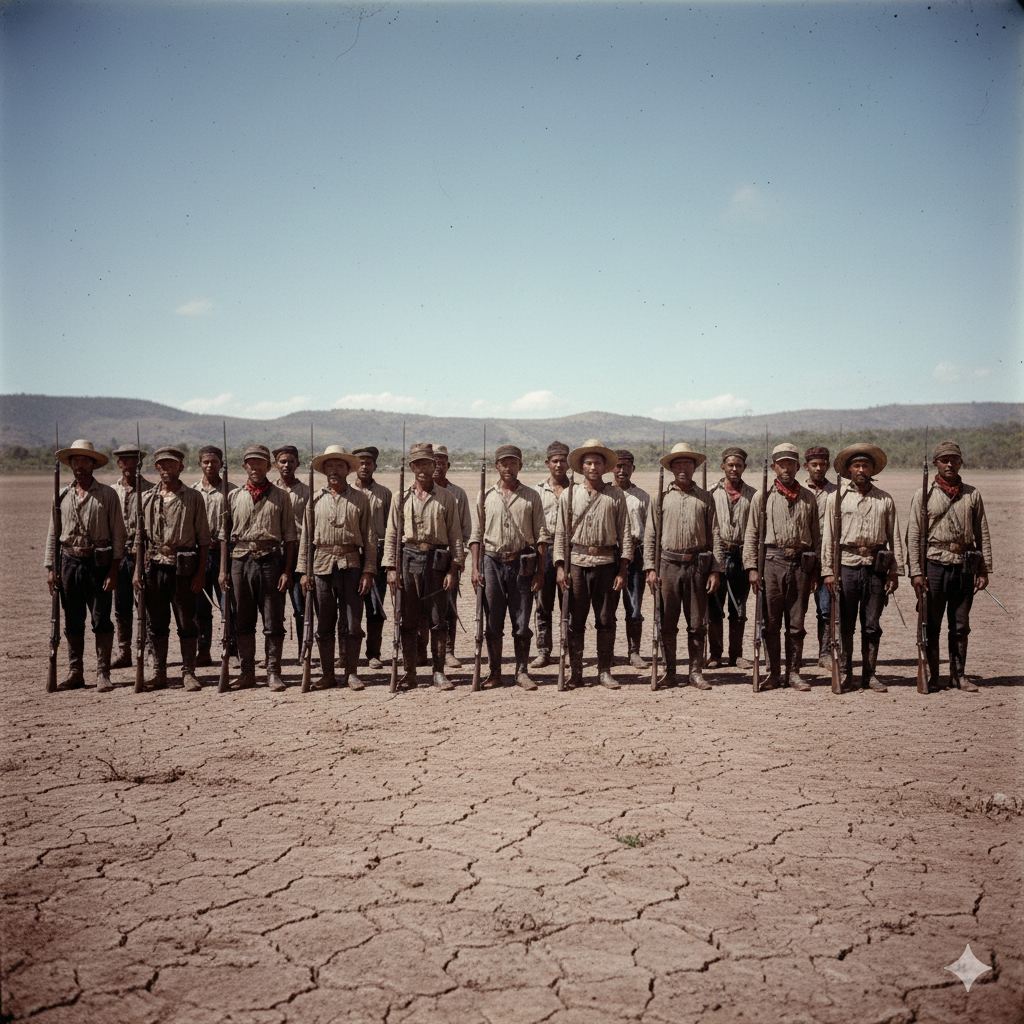
At its heart, Panama is the story of a young French graduate who is rapidly promoted to chief engineer of the 19th century’s greatest engineering project.
He must overcome underhand American opposition, murderous revolution, widespread disease and corruption in a true story that still reverberates today.

Episodes 1–2: The dream is born (ambition, romance, tragedy).
Episodes 3–4: Success, then collapse (glory, jealousy, death, corruption).
Episodes 5–6: Reinvention in America (personal sacrifice vs ambition, propaganda war).
Episodes 7–8: Revolution and resolution (independence, betrayal, legacy, redemption).

Main: Philippe
Character arc goes from idealistic graduate engineer to cynical political manipulator, including falling in love with Pauline, turning away from to complete the Panama project, an obsession due to his need to accepted by French society, having been bullied at school for illegitimate)
Antagonist: JT Morgan
The racist, Ku Klux Klan senator, whose notoriety was due to his outspoken support of vigilante murders of blacks and his schemes to deport Blacks. His political influence rises as he dominates the Senate Foreign Relations Committee. Despite heavily backing the Nicaraguan route in order to support the Southern ports of Galveston, New Orleans and Mobile, he suffers a humiliating defeat in the Senate at Philippe’s hands.
Romantic: Pauline
Pauline’s arc starts as an anxious wife travelling out to Panama to meet her husband who she’s not seen in two years, only to find he’s died and she’s a penniless widow stuck there without enough money for the return fare. She bumps into Philippe, with whom she had established a good rapport on the voyage over, and accepts his suggestion to work for him for a short time to earn her passage back and to get her dead husband’s back pay. He falls in love with her, and although she holds back because he is intent on staying on in Panama - the country of disease and death - their love flourishes. When he himself nearly succumbs to Yellow Fever, she rescues him by putting him in her berth on the steamer back to France and nurses him to recovery. They plan to marry in Paris, but Philippe breaks her heart by letting her down to fulfil his inner need of completing the canal. She refuses all correspondence with him, until he dramatically reappears to win her over in the final, moving denouement.
Business/Family: Maurice
Pauline’s arc starts as an anxious wife travelling out to Panama to meet her husband who she’s not seen in two years, only to find he’s died and she’s a penniless widow stuck there without enough money for the return fare. She bumps into Philippe, with whom she had established a good rapport on the voyage over, and accepts his suggestion to work for him for a short time to earn her passage back and to get her dead husband’s back pay. He falls in love with her, and although she holds back because he is intent on staying on in Panama - the country of disease and death - their love flourishes. When he himself nearly succumbs to Yellow Fever, she rescues him by putting him in her berth on the steamer back to France and nurses him to recovery. They plan to marry in Paris, but Philippe breaks her heart by letting her down to fulfil his inner need of completing the canal. She refuses all correspondence with him, until he dramatically reappears to win her over in the final, moving denouement.
Business/Family: Maurice
Goes from being a young banker who is given the huge responsibility of placing the Panama Canal Company shares to retail investors, due to Philippe’s position as Chief Engineer, to reluctant highly indebted business partner when Philippe buys the biggest contractor on the Panama project, which will eventually make them both incredibly rich, and cause their downfall when the Inquiry Tribunal condemns all Company participants for profiteering.
Personal/Social: Isaac & Rebecca Turner
Goes from being a young banker who is given the huge responsibility of placing the Panama Canal Company shares to retail investors, due to Philippe’s position as Chief Engineer, to reluctant highly indebted business partner when Philippe buys the biggest contractor on the Panama project, which will eventually make them both incredibly rich, and cause their downfall when the Inquiry Tribunal condemns all Company participants for profiteering.
Political: Dr. Amador & Nurse Maria
They work together in the clinic at Colón where the doctor falls in love with the fiery Maria. They get married and have a big wedding ceremony, attended amongst others by Philippe and Pauline. They become politically oriented due to the neglect of Panama by the Colombians, and will fight for national independence. Amador becomes the first President of Panama.

Cold Open
The story starts with a cold open on November 3rd 1903, with Philippe and the head of the US railroad in Panama dragged before a firing squad of Colombian troops who were forewarned of the revolution for independence.
It then reverts to 1881 and the 20 year timeline is melted into a continuous flow, without further interruption of dates.
The Set Up
Philippe attends a presentation by the French national hero, Ferdinand De Lesseps, the constructor of the Suez Canal, at the most prestigious engineering school in the world, where Philippe is a model student. Caught up in the wave of patriotism and ostensibly in a quest for national and personal glory, Philippe decides to leave for Panama on graduation. The real, subconscious reason for his leaving is a reaction to having been taunted and bullied throughout his life for a dubious parentage, which leads him to imagine that only a huge, glorious success will lead to his being accepted by Parisian society. This is the driving force behind his all-or-nothing determination to complete the canal, despite overwhelming odds, and to which President Theodore Roosevelt will later ascribe the sole reason for the success of the project.
On the steamship voyage to Panama, Philippe has the good fortune to meet Jules Dingler, the chief engineer of the project, whom he dazzles with his brilliance, and who immediately promotes him to senior engineer, responsible for the project’s most difficult cut. Also on the voyage, he strikes up a good rapport with the beautiful Pauline, the soon-to-be-widowed wife of a French engineer.
Meanwhile, Senator JT Morgan concocts a scheme to deport as many blacks as possible from the USA, and the poor, black family of Isaac and Rebecca Turner is persuaded to take the offer of money to emigrate, while also hoping to leave the atmosphere of the Jim Crow laws behind and start a new life. JT Morgan commissions Admiral Walker to produce a comparative study of the Nicaraguan and Panamanian routes, with the instruction to come down in favour of the Nicaraguan one, which he believes will favour the Southern ports of Galveston, New Orleans and Mobile, which haven’t recovered from the damage caused during the civil war.
In Panama the main thread of Philippe continues, with panoramic backdrops of steam shovels toiling in wide open or jungle landscapes. He bumps into the widowed Pauline, who has spent all her money and is unable to return to France. He offers her a job as his secretary to earn enough to get back home, while he tries to sort out her dead husband’s back pay. While working together, Philippe is increasingly drawn to her, and it becomes clear that he is in love with her when he saves her from xenophobic rebels in Colón.
In the hospital in Colón, Panama, Dr Amador is drawn to Maria, the fiery, left-wing and deeply humane nurse, whom he will marry and plot the independence of Panama. Both become friends of Philippe, as he often visits sick workers in the hospital and is continually asking Dr Amador to explain the possible causes of and cures for the prevailing diseases of malaria and yellow fever.
In Paris, where there is mass middle class hysteria for the Canal Company’s stock, Philippe’s brother, Maurice, a banker at Credit Lyonnais, is promoted to be in charge of the distribution of the stock to retail investors.This is partly due to Philippe’s new, elevated position in the Canal Company.
Also in Paris, ex-US ambassador to France, John Bigelow, witnesses an adoring crowd worship Ferdinand De Lesseps during a capital raising, while explaining the interest of the United States to a young American journalist from a New York newspaper. It is clear that he is sceptical of the Canal Company’s prospects due to the endemic corruption, but favours a route through Panama as being in the best interests of the USA.
Tragically, Jules Dingler, the chief engineer of the project, commits a spectacular suicide after losing his wife to disease, after having already lost both his children. Given the dearth of healthy engineers, Philippe is promoted to chief engineer of the largest engineering project in the history of the world at the age of 26.
The Middle Stories
Philippe is faced with scepticism by La Veille, the French Consul-General in Panama, due to his young age. He eloquently rebuffs this and invites La Veille to accompany him during his working day which starts at 2am and finishes at midnight. There follows a montage of various scenes including explosions across the scenic landscape, trips to the hospital to visit sick and injured workers, and meetings with engineers. La Veille becomes one of Philippe’s biggest supporters, and as the government’s representative in Panama, his opinion carries weight. In fact, he’s so impressed that he recommends Philippe to the government to receive the Legion D’Honneur medal. This sparks jealousy in the hugely vain Ferdinand De Lesseps who conspires to humiliate and demote Philippe on his forthcoming trip to Panama accompanied by journalists and bigwigs.
The Turners arrive in Panama. Isaac is assigned to a bunkhouse, but there is no accommodation for Rebecca and the kids. It is clear that the move has been a huge mistake.They find an abandoned shantyhouse where the previous occupants had died from disease. The conditions are insalubrious. The Turners thread continues with the bleak story of the youngest falling sick and eventually dying. Isaac is badly injured in a work accident with a steam shovel (under Philippe’s watch) and, later in the story, will succumb to disease. He will be buried in an unmarked grave along with the other deceased workers. Philippe feels partly responsible, and with Pauline, occasionally does the rounds to distribute alms. Eventually, Rebecca will be one of the luckier ones, and find work as a housemaid in Philippe’s house, and he will take her and her teenage kids back to Paris.
In Paris, there is another capital raising for the French Canal Company, not long after the last one, and tongues start to wag. There are rumours of a huge overspend and that corruption is rife. The shares are widely owned by the middle classes and are very overvalued. The family butcher pesters Philippe’s mother, Madame Bunau-Varilla, in the street for news about Panama as the share price sinks. Foreign newspapers report accurately on the situation, but the French press is fed cash by the company to keep it compliant.
In Panama, Philippe surveys the results of the dredging operation on the Pacific side where he is proven right that the channels won’t silt up again after having studied the water currents. On hearing that there is a spate of widespread killing by a xenophobic band of rebels, Philippe and Amador board the train together in Panama city to save the women in their lives, Pauline and Maria. We are apprised of the fact that the United States has the legal right to intervene to save the American railroad (this is key to the final scenes) that runs from Colón to Panama City. Philippe finds Pauline in her lodgings and takes her to safety - the Dinglers’ abandoned mansion - where she declines his gentle advances, as it’s too soon after her husband’s death.
Admiral Walker reports to Senator JT Morgan about his findings comparing the Nicaraguan Panamanian routes. Morgan insists on having a 3000 page report that nobody else in the Senate will read, so that he can control the entire process. Morgan is also worried by the progress Philippe is making in Panama, getting the French project back on track. He later visits JP Morgan senior to plot with him the downfall of the French Canal Company.
The main story then picks up again with the visit of De Lesseps and a horde of journalists and bigwigs to see the progress of the project, which, thanks to Philippe, is back on track. De Lesseps loves the limelight and demotes Philippe to the amazement of many, including La Veille, who is outraged. Philippe is visibly deflated, not helped by the imminent departure of Pauline for Paris where she has a young child to attend to. In the aftermath of the visit, Philippe contracts Yellow Fever and is on the verge of death when Pauline shares her ship’s berth with him to take him back to France. She nurses him and he slowly recovers. They make love and he tells her about his childhood, where he was often bullied at school due to his parentage.This awakens memories in him of being rejected by his father who only wished to recognize Maurice. They discuss many things: she says he can have a wonderful career in France.Implicit is that they will marry. Why doesn’t Philippe propose? Does he already know that he is going back to Panama? One detail of a conversation that sets up the very last scene is that he asks her what she will miss most about Panama and she replies the fruit.
However, during his convalescence in Paris, Philippe is visited by John Bigelow, the ex- American ambassador to France. Bigelow plants the seed of an idea in him: namely the American way of free enterprise and how to rescue the doomed project. Philippe mulls this over, and is very torn because of his recent betrothal to Pauline. He also needs to borrow money on a large scale, which can only be done in conjunction with his brother who works at the Credit Lyonnais, but who will almost certainly not leave his comfortable banking job for a pie-in-the-sky dream to salvage a failing infrastructure project. The urge for demonstrable career success is greater than his love for Pauline, and Philippe commits to buy in both his and his brother’s names the largest contracting firm on the Panama project (which probably wanted out anyway), Artigues and Sonderegger. He then informs Maurice that they will need a loan of 5 million francs and tries to convince him of his engineering methods that will save the project and enrich them. Maurice is not amused by Philippe’s proposal, but cannot refuse the fait accompli and accepts when Philippe explains the terms of the contract that he can negotiate with the Canal Company. The risk is that the Company will go bust before they get wealthy, but Philippe is convinced that his ideas of using underwater explosives to help the dredging and building evacuation bridges to avoid mudslides will enable them to accelerate the excavation processes and exceed their negotiated targets with the company to a great extent.
Philippe then has to inform Pauline of his decision to return to Panama. Not surprisingly, this does not go down well. She has already lost one husband to disease in Panama, a country that she equates with death. Both are broken-hearted.Philippe wanders the streets of Paris in obvious pain. He prays in a church but the outcome is never in doubt: He will return to Panama. The clock is ticking…He has to get rich before the company goes bankrupt.
He writes to Pauline, but she burns the letters without opening them.
Two of his engineering ideas are portrayed: the building of evacuation bridges so that the excavated mud doesn’t keep piling up, causing devastating mudslides that wipe out weeks of work. And the use of explosives in fissures of rock, which are then reduced to rubble, allowing the dredgers to move in. In one action scene, Philippe strips to his long johns and dives into the water to check that the explosives have been inserted correctly. Unbeknownst to him, the pool is teeming with poisonous, aggressive snakes that head towards him and are shot at from the side as Philippe hurriedly escapes.
Interspersed with this are an elaborate plot by JT Morgan with JP Morgan to scupper another French financing, while in the French parliament, la Chambre des Députés, politicians debate whether to allow yet another Canal Company financing or to allow the company to go bankrupt, which would devastate the middle classes. By this time, all the politicians are on the take and the bill is passed to much hysterical relief. But during the financing itself, a rumour is spread in a newspaper article that the aging Ferdinand De Lesseps has died, and the capital raise fails, sending the company into bankruptcy.
Maurice, from his opulent office overlooking the half-built Eiffel Tower, sends a telegram to Philippe that the game is up and Philippe departs Panama, after taking his leave from the devastated Amadors, as they hope for independence, and the squalid isthmus has no hope of standing alone economically without a canal.
Both Philippe and Maurice have become very wealthy, and have bought a big national newspaper, which Marice runs. But all participants in the canal venture face a tribunal of inquiry. There is a suicide and one politician pleads guilty to taking a bribe. Georges Clémenceau, the future president, fights a duel to clear his name. All the politicians all get off lightly.
Gustave Eiffel is convicted of profiteering. Next up are Philippe and Maurice, who have become very wealthy. Aspersions are cast about the use of brothels for the men under Philippe’s watch, but aside from buying a private contractor to carry out excavation works with incentive criteria that had already been set, thereby enriching themselves, nothing incriminating can be found. However, it is a long way from Philippe’s personal dream of glory. They are fined and all participants have to buy worthless shares in a newly formed canal company. The fines put the Bunau-Varilla brothers under some financial pressure at a time when they are heavily invested in the newspaper company, and new printing presses are needed. Philippe desperately needs to find a buyer for the worthless new canal company shares that he owns.
The End Game
John Bigelow approaches Philippe: Congress will vote imminently on the canal route. Nicaragua or Panama. And the former is heavily favoured due to the machinations of JT Morgan, who manipulates the commission’s findings. Bigelow asks Philippe to come to the States to make a round of presentations to try to open the debate up.
Despite hecklers placed at the business conventions, Philippe’s rounds of presentations to influential businessmen go well, with Philippe emphasizing the risk of volcanoes in Nicaragua: just one eruption could totally submerge a whole canal in dust and debris many times over. He is invited to Washington and a showdown with JT Morgan is arranged: it is a trap. In front of a photographer, Morgan baits Philippe, and finally elicits the desired reaction when he mentions his parentage. The resulting picture of Philippe launching himself at the senator makes all the papers.
In a Senate hearing, Admiral Walker’s recommendation comes down marginally in favour of Panama, but the combination of his weak presentation and aspersions being cast about how long he was wined and dined in Paris by the leaders of a corrupt, bankrupt French company, ensure that Nicaragua is the front runner.
Philippe devises a plan to use the same methods that JT Morgan used to scupper the French company: namely, to plant false information. In a memorable scene, on the day of the vote in the Senate, all members receive a postcard with a Nicaraguan stamp on it with a picture of a volcano. Added to which, several newspapers report on the front pages that there has been a large volcanic eruption in Nicaragua. Philippe and Bigelow watch on as Senator Morgan vainly waves a personal telegram from the Nicaraguan president assuring him that there has been no eruption. The vote goes to Panama, and the deeply detestable Morgan is humiliated.
But it isn’t over yet. The Colombian government sees the opportunity to extract money from Washington and demands $10 million for the transfer of the French concession. Theodore Roosevelt refuses, although he clearly favours the Panama route. JT Morgan pushes again for Nicaragua. Philippe is desperate. He contacts Amador, who he meets in New York, and together, they concoct an elaborate plan: to suborn the Colombian troops in Panama and declare independence. However, when Bogota inevitably sends a ship with troops, they will need American troops present (who have the legal right to defend the railroad) to be present to prevent bloodshed and to ensure that the revolution is successful. Philippe goes to the State Dept, which arranges a meeting with President Roosevelt, who cryptically hints at lending his support to the venture. This will be the most controversial act of his presidency.
In a last roll of the dice, Philippe sends $100,000 to the revolutionaries (via Amador) in Panama to suborn the garrison. He himself arrives in Colón on the day of the revolution. But disaster strikes: Bogotá got wind of the revolution, and sent a ship full of troops earlier than expected. With no American marines to defend the railway line and the rebellion, Philippe and Colonel Shaler, the head of the railway, are hauled before a firing squad (the same scene as in the cold open). Only some fast talking gets them out of trouble and he luckily persuades the Colombian officers to take a train separately from their men to Panama, on the pretext that the train will return with more carriages for the Colombian troops. The Colombian officers are overpowered in Panama, and then the (half-) promised American warship, the Nashville, appears. US marines disembark and there is a stand off with the Colombians until Philippe offers the sole remaining officer $5000 to reembark with his men.
With the new Republic founded, one of Philippe’s conditions for supporting the revolution was that he be appointed Special Ambassador to the new state of Panama. He hurriedly sails to Washington and, with his contact at the State Dept, draws up the famous and controversial “unequal” treaty which accords the USA a 10km wide sovereign strip either side of the canal. He rushes to sign this minutes before Amador and his advisors arrive at the Washington train station and presents them with the fait accompli.
In the final scene in Paris, Philippe discreetly follows Pauline to Les Halles food market, where he has already placed a basket of Panamanian fruit with a vendor. When she sees the bananas, mangos and avocados, Pauline turns around to see Philippe and they are tearfully reunited.




